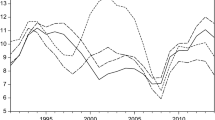Abstract
The dispersion of U.S. state unemployment rates and those of many industrialized countries has been observed to maintain persistent dispersion. This paper, by using a model of conditional expectation, investigates the question wheter there was a tendency toward convergence or divergence of the U.S. state unemployment rates. The paper identifies the states that persistently performed above or below unemployment expectations on average for the period 1978–1999. Data were provided by the U.S. Bureau of Labor Statistics.(JELR10)
Similar content being viewed by others
References
Baumol, W. 1986. “Productivity Growth, Convergence and Welfare.”American Economic Review 76: 1072–1085.
Blackley, P. R. 1989. “The Measurement and Determination of State Equilibrium Unemployment Rates.”Southern Economic Journal 56: 440–456.
Bureau of Labor Statistics. 1997.BLS Handbook of Methods. Washington, DC: U.S. Department of Labor, Bulletin 2490.
Bureau of Labor Statistics. 2000. http://www.bls.gov.
Carlino, C. A., and L. Mills 1996. “Testing Neoclassical Convergence in Regional Incomes and Earnings.”Regional Science and Urban Economics 26: 565–590.
Cohen, D. 1996. “Tests of the ‘Convergence Hypothesis’: Some Further Results.”Journal of Economic Growth 1: 351–361.
Collver, A., and M. Semyonov. 1979. “Suburban Change and Persistence.”American Sociological Review 44: 480–486.
Congdon, P., and J. Shepherd. 1988. “Components of Social Change in Urban Areas.”Urban Studies 25: 173–189.
Davidson, R. N. 1976. “Social Deprivation: An Analysis of Intercensal Change.”Transactions of the Institute of British Geographers I.N.S.: 108–117.
Freedman, D., and D. Lane. 1981.Mathematical Methods in Statistics: A Workbook. New York: W. W. Norton and Company.
Galor, O. 1996. “Convergence? Influence from Theoretical Models.”The Economic Journal 106: 1056–1069.
Gunther, W. D., and C. G. Leathers. 1975. “Trends in Income Inequality in the South, 1950–1970.”Growth and Change 6/7: 19–22.
Kleinbaum, D. G., L. L. Kupper, and K. E. Muller. 1988.Applied Regression Analysis and Other Multivariable Methods. Boston, MA: PWS-KENT Publishing Company.
Larson, H. J. 1982.Introduction to Probability Theory and Statistical Inference. New York, NY: John Wiley & Sons.
Malizia, E. E., and S. Ke. 1993. “The Influence of Economic Diversity on Unemployment and Stability.”Journal of Regional Science 33: 221–235.
McClendon, M. J. 1977. “Structural and Exchange Components of Vertical Mobility.”American Sociological Review 42: 56–74.
Newman, G. R., and R. H. Topel. 1991. “Employment Risk, Diversification, and Unemployment.”Quarterly Journal of Economics 106: 1341–1365.
O’Leary, E. 1997. “The Convergence Performance of Ireland Among EU Countries: 1960 to 1990.”Journal of Economic Studies 24: 59–71.
Ostle, B., and L. C. Malone. 1988.Statistics in Research. Ames, IA: The Iowa State University Press.
Pantuosco, L., and D. Parker. 1998. “Sources of Prevailing Differences in Unemployment Rates for Selected Regional Pairs.”The Review of Regional Studies 28: 35–46.
Partridge, M. D., and D. S. Rickman. 1995. “Differences in State Unemployment Rates: The Role of Labor and Product Market Structural Shifts.”Southern Economic Journal 62: 89–106.
Partridge, M. D., and D. S. Rickman. 1997. “The Dispersion of U.S. State Unemployment Rates: The Role of Market and Non-Market Equilibrium Factors.”Regional Studies 31: 593–606.
Riefler, R. F. 1995. “Comparative State Employment Growth: An Exploratory Investigation.”The Review of Regional Studies 25: 187–205.
Siegel, P. B., J. Alwang, and T. G. Johnson. 1994. “Toward An Improved Portfolio Variance Measure of Regional Economic Stability.”The Review of Regional Studies 24: 71–86.
Author information
Authors and Affiliations
Rights and permissions
About this article
Cite this article
Nissan, E., Carter, G.H. Convergence-divergence of U.S. State unemployment rates. J Econ Finan 25, 172–180 (2001). https://doi.org/10.1007/BF02744520
Issue Date:
DOI: https://doi.org/10.1007/BF02744520




